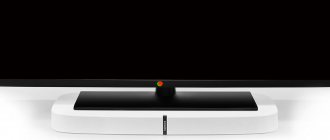Why does TV show in black and white? Modern TVs, unlike their predecessors, have excellent color and image quality. Leading world-famous companies are constantly developing new display formats, delighting equipment owners with incredibly realistic pictures.
However, in the case when at least some kind of malfunction appears in the TV, we begin to feel some kind of degradation of the equipment, for example, we are accustomed to the fact that the picture should be of very high quality, no interference is allowed, and a black and white image completely sends us to several decades ago. However, a black and white screen can appear on a completely modern TV.
Why does the TV show no color?
The loss itself, and in some cases the distortion of the color gamut of the TV, does not have a specific source in the form of a part or assembly. Such breakdowns are common to absolutely all types of TV, regardless of manufacturer, model, or year of manufacture. To be fair, it is worth noting that, after all, they are more typical for CRT models. The culprit for the loss of color characteristics of the image can be antennas, sometimes owners set the wrong settings, sometimes malfunctions can occur in TV modules or picture tubes, and sometimes the picture tube demagnetization system leads to similar malfunctions.
How can we understand that color has disappeared on TV?
1. Lack of color in the image (gray picture). 2. The TV only shows one color (red, blue, green). 3. The contrast of the picture is impaired: the predominance of one color, the absence of just one of all colors. 4. Spots, stripes, flickering colors, shimmering colors.
Of course, only a service engineer or a teleworker called to your home can fix all types of malfunctions. With his experience, tools and parts stock, he will quickly determine the root cause and repair your TV. But sometimes, you can perform the initial diagnosis yourself. True, this is not recommended. It is easier to cause harm than to benefit, but it is up to the owner to decide.
Do-it-yourself TV repair: how to restore color to the image?
Depending on the root cause, there are several ways to fix it. If there is no image in the complex, the color has disappeared, and this has a negative impact on sound reproduction, most likely the problem is in the signal reception and settings.
First of all, we check the connection of the antenna, connection plug, signal reception strength (it is possible that other channels are shown without problems). If the picture is clear but lacks color, check your TV settings. Using the remote control, call up the menu, try changing the contrast, color saturation, change the color system. If the red or green color disappears, the reason may be a malfunction of the color channel or picture tube. It is necessary to update the contacts on the TV chips, check the contacts on the boards inside the case. To remove color spots from the TV screen, you should check the magnetization system of the kinescope. By turning it on/off for a few minutes, the fault will be checked.
Does the TV show no color? Call the TV technician!
If the problems persist, or the owner does not know how to fix them, call a technician. Calling a telemaster will solve all problems, and also save you from wasting energy, nerves and time. All work will be inexpensive, and repairs will most likely be cheaper than buying new parts. But the decision is yours - to easily repair the TV, or try to repair it without special skills and equipment.
Free consultation or call a specialist to your home: +7(499)391-04-99.
Source
Probable causes of the malfunction and their elimination
When color or contrast disappears on a TV, or a predominance of one color is observed, there can be many reasons for this behavior. We will consider only the most popular of them, first focusing on those that can be corrected by the user himself.
Problems with TV settings
Very often, such problems are associated with incorrect TV settings. This is not a breakdown or malfunction, but simply a system failure. It can be caused either by careless handling of the switches in the menu, or by a small power surge.
Repair
This defect can be corrected as follows:
- try turning off the TV from the network, and then turning it on after 10 minutes;
- further in the menu, make adjustments to color, brightness, contrast and other parameters, since there is a possibility that an overestimated indicator of one of the characteristics gave such a result;
- If none of the above helped, then try resetting the settings to factory settings using the corresponding menu item.
Problems with signal reception settings
Very often, the reasons for this behavior of TVs are related to the signal reception settings. On older models, there is a possibility of confusing the SECAM and PAL modes, which turns the picture into black and white. Also, incorrect settings for the reception of analog channels can give a similar result, especially if it is combined with a weak signal level.
Repair
Troubleshooting such problems is done as follows:
- try adjusting the antenna or searching for channels again;
- check in the menu settings that the signal type matches the settings, namely the SECAM and PAL values;
- try resetting all settings to factory settings;
- Quite often, problems do not arise in the TV itself, but in the supply, player or other device transmitting the signal, which can be checked by disconnecting it.
Strong magnetic fields from other devices
If you have a CRT TV, then it may be affected by the magnetic fields of other equipment or the screen demagnetization system may be faulty. Typically, plasma and LCD TVs do not have these disadvantages. Therefore, specific repairs are necessary.
Repair
If the screen is magnetized, use the following tips:
- turn off the TV for 10 minutes and turn it on again;
- if necessary, repeat the procedure several times;
- if the device has a special button or combination of buttons for demagnetization, then it is worth using it;
- move away all extraneous electrical appliances or other sources of magnetic radiation from the TV;
- if the problem is not solved, and the defect is precisely the magnetization effect, then you need to use a special device, which is usually available to service center technicians.
Firmware problems
Modern TVs are equipped with their own software that is responsible for control. Very often they exhibit certain glitches or fail completely due to minor changes. As a result, there may be no sound, the picture quality may change, or the color red, green, or blue may become contrasting.
Repair
Troubleshooting such problems is done as follows:
- if the menu is available to you, then you need to connect the TV to the Internet and perform a regular update using a special item;
- some models support updating from a flash drive, which involves downloading from the official website to a similar medium;
- Some software failures require a complete firmware update of the TV, which is best done by a technician who has the necessary equipment and software.
The color adjustment board has failed
If, in addition to the main defect, the TV exhibits spots, stripes, color flickering, iridescence and other malfunctions, then this is most likely due to a problem with the color adjustment board. For some TV models it is part of a specific block, while in other devices it is made in the form of a microcircuit.
Repair
It is not recommended to repair this element yourself. Even from the same manufacturer, such boards may look different and be located in completely different places. Therefore, you need to call a technician, indicating the type of fault and the model of your TV. This will allow him to immediately take a certain supply of parts that may be required during repairs.
Loss of screen brightness and contrast - causes and their elimination
The loss of brightness of an LCD type screen occurs due to the failure of the lamp located behind the multilayer structure. Under fairly intense loads, the lifespan of the lamps responsible for the correct operation of the device averages from 5 to 7 years, provided there are no sudden temperature changes. To restore the previous performance of your TV or computer, sometimes it is enough to change the lamp.
If there is oxidation of the contacts or their damage, flickering occurs, loss of contrast and subsequent shutdown of the lamp. In this case, the contact is replaced or cleaned if it is not damaged. If the image goes out after a short period of operation, then the possibility of a manufacturing defect cannot be ruled out. Another nuance is that poor-quality soldering, often performed during warranty repairs, can lead to such sad consequences as the destruction of the microcircuit by the remnants of the active flux used during soldering.
Green screen on TV
A TV malfunction associated with a change in image color is most often associated with a failure of the video amplifier. Therefore, if, for example, the TV screen turns green, the breakdown should be looked for first of all on the picture tube (PC) board.
However, several reasons can lead to a green screen:
- Breakdown of the transistor (when painted green, there is a malfunction of the Green video amplifier);
- Closing the cathode with the modulator;
- Capacitor leak in the video amplifier circuit;
- The microcircuit itself is faulty;
- Loss of emission from the cathode.
Let's start with the first one. Let's look at the example of a kinescope board with video amplifiers for a Vestel TV.
From the diagram it can be seen that the green image depends on transistors Q902, Q905. Transistors should be checked first. Determining the malfunction can be started by measuring the voltage at the output of the green kinescope; if the Q905 transistor is broken, it will be significantly less than 90 volts.
The normal output voltage for a video amplifier is 90 - 160 volts; if it is less, the screen will be illuminated with the color whose channel is faulty. If the voltage is more than 160 V, then this color will be absent, since the modulator will be closed by such a high voltage.
I’ll note right away that this is relevant for similar faults: the TV screen is red and, accordingly, the screen color is blue.
When the cathode and modulator are short-circuited, the greenish color of the screen will be accompanied by more lines. progress (LOH) and the image may not be visible at all through the green background. The image can be achieved by reducing the accelerating voltage Scren. In this case, “shooting” or lightly tapping the guns (in order to disengage them) can help, but as they say, it’s not necessary here once at a time. To shoot, take a 100uF*450V network capacitor, charge it with constant voltage and discharge it by touching the modulator and cathode terminals. It will help well, no, I still don’t need to change the kinescope.
The TV screen can also turn green due to faulty capacitors in the wiring of the video processor and video amplifier microcircuits, so even ceramic ones must be checked (or better yet, simply replaced), although these are quite rare cases. First of all, the capacitor for a 220 V power supply must be replaced, somewhere around 47 - 100 m * 220 V, with a large leakage and loss of capacitance it has a very strong effect.
If video amplifiers are assembled not on discrete elements, but in one microcircuit, then the TV screen still turns green, although rarely, the same thing happens.
In this case, disconnect the circuit to the kinescope from the green output leg and measure the voltage. If the voltage at the output remains less than the permissible value, then you still need to check the power supply capacitor and the capacitors in the harness, and the signal level from the processor to the chip. Changing the IC did not help. At normal voltage, with the disconnected leg, check the resistance between the cathode and the modulator; most likely the green color of the screen will be due to their short circuit.
The long service life of the TV, 10 years or more (that's when) leads to loss of emission from the cathodes, which can also give an image of this color. According to the intensity of use, the colors are approximately distributed as follows:
Therefore, the red color disappears first, the second in intensity is green, and if its cathode has not lost emission, then it will illuminate the image. There are schemes for shooting cathodes to increase their emission, it helps for a while, but it is better to replace the kinescope, or even better, the TV.
Source
What to do if there is no color on the TV when connected via a digital tuner
The main mistake beginners make when detecting a malfunction is panic. The person believes that he has damaged something, or that the equipment is faulty and needs repair. This is wrong. If there is no color image when connecting a digital set-top box to the TV, the reason may be the settings or incorrect equipment connections. Let's look at the instructions for action in more detail.
Check the integrity of the wires and the quality of the connections
First, check the entire connection path between the TV and digital set-top box
If there is no color in the image, pay attention to the quality of the installation of the wires in the existing connectors. Sometimes the problem occurs due to the cable not being fully inserted or damage to its surface
Reboot the equipment
If there is no color when connecting the digital set-top box to the TV, reboot the equipment. Color problems can arise due to glitches in the tuner software, and after a reboot the situation usually corrects itself without additional intervention.
Check that the TV color mode is set correctly
This is one of the reasons why there is no color on the TV - the wrong mode was selected. To fix the problem, follow these steps:
- Enter the TV menu.
- Go to settings.
- Find the color mode control. The name may vary depending on the brand and model.
- Select Auto mode or set to PAL option.
By performing these steps, you match the settings of your digital set-top box and your TV. If this doesn't help and there is still no color in the picture, move on to the next step.
Check your set-top box settings
If the TV does not have a color image when you connect the set-top box, check the settings of the tuner itself. To do this, take the following steps:
- Enter the menu of the receiver connected to the TV.
- Find the Image/Screen Format section (the name depends on the equipment model).
- Find the TV Format subsection.
- Make sure the settings are correct.
If the settings of the digital set-top box were PAL-N, change it to regular PAL. As a rule, a color image appears on the screen. If the manipulations did not produce anything, and there is no color in the image, as before, proceed to the next check.
Check that the equipment is connected correctly
Depending on the brand and model of the TV or digital set-top box, the connection can be made using tulips, HDMI, SCART or other connectors. But the process does not always go smoothly. For example, Philips or Samsung TVs do not have the ability to directly connect a T2 tuner to the TV using RCA. This is due to the absence of such an input.
To solve the issue, a composite connector is provided, which uses only one wire. In a regular RCA connector, the video wire is colored yellow. The component version uses green, blue and red cables for video transmission. In new TVs, such connectors are usually made universal. For convenience, the green component connector is outlined in yellow.
When connecting the yellow wire to the universal connector of a digital set-top box, the user is faced with a situation where there is no color on the TV screen. There are several solutions here:
- Find and use a regular composite input, if provided.
- Use other connectors - HDMI or SCART. In this case, you need to purchase an additional cable, because it is not included.
On some Samsung TVs, SCART and RCA connectors are implemented through adapters that come with the TV. The problem is that if they are not used to begin with, they are quickly lost. In this case, the only way out is to connect the set-top box via HDMI, where there are no difficulties with switching and there is no need to use additional adapters.
Update your software
If you haven't updated your set-top box software in a while, do so. Sometimes there is no color in the image due to software glitches or an outdated version of the program. If the download does not occur automatically, the required version can be downloaded from the official website and downloaded taking into account the manufacturer's recommendations.
Checking the connection
Some models, especially Samsung and Philips, do not allow you to directly connect the T2 tuner to the TV with “tulips” (by the way, “tulips” are an RCA cable), since they do not have an RCA connector. In this case, there is often a component connector. When you connect the yellow cable to the green input (the hole is located behind the TV), you will get a monochrome image.
The consequence of the problem is incorrect cable connection. For video there is a standard yellow wire, and for video behind the TV there are three cables: yellow, blue and red. On modern TV models, the green component jack is represented by a yellow circle. You can try adjusting the image by connecting the RCA cable correctly.
Why did the TV turn black and white?
- Problems due to incorrect settings.
- Poor quality signal.
- Interference from other devices.
- Malfunction of the color reproduction board.
- Defects in the firmware.
Some of the reasons that caused the lack of color rendition can be eliminated yourself. For example, restore lost settings. But to correct other problems, you will need to invite an experienced specialist who not only has the necessary knowledge, but also has a special tool.
Let's look at each and the reasons separately.
Settings failed
If color reproduction is disabled on only one channel, it can be restored using the remote control. Go to the menu and set the color to the desired range. If this does not bring results, then most likely this is not the case.
In Russia, all channels are usually tuned to the SECAM playback system, all state channels work on it. But if you have cable TV, some channels may be set to PAL. You need to look in the settings and switch the system to color image.
Poor quality TV signal
If the TV turns black and white, this may be due to a faulty antenna. Perhaps its plug is not inserted all the way, or the antenna itself is faulty. You need to make sure the plug is connected correctly.
- If the antenna is indoor, then twist it or move it from place to place to find the best signal reception point.
- If the antenna is outdoor, then you need to inspect it. It may have been damaged or moved by a strong gust of wind.
It is possible that a low-quality signal is being transmitted by a faulty tuner, set-top box or other transmitting device. In this case, you need to inspect and repair this device.
Electromagnetic interference from other devices
Also, black and white channels on a TV may appear when it is exposed to a strong electromagnetic field from another device. Owners of CRT television receivers often encounter such manifestations. LCD and plasma models are not subject to such influences.
If the TV has lost its color due to demagnetization, firstly, you need to move away all devices that generate an electromagnetic field. Then, you need to completely turn off the TV for a while and reconnect it. If this does not help, you can find the demagnetization button on the device body and press it. If after this the color rendition has not returned, then you need to contact a specialist who, using special equipment, will carry out demagnetization.
Malfunctions of the color reproduction board
More complex failures, when the TV shows in black and white, include a malfunction of the color reproduction board. In this case, the image may be completely absent, or can only be reproduced in black and white mode.
Only a specialist can repair this damage. Because in this case, replacement of the part is required.
Defects in the firmware
Modern manufacturers such as LG, Samsung, Sony, Philips and others equip devices with their own software. This ensures high quality playback of the device. But sometimes situations arise when, due to a power surge or a short circuit, a defect appears in the TV’s firmware that affects the quality of playback. How to fix the picture in this case?
- Connect the TV to the Internet and download the latest operating system updates from the manufacturer’s official website.
- Download updates to a flash drive. Then install it in the TV and reflash it.
- Contact a technician who will reflash the system.
There are many reasons why your TV began to show in black and white. It can be quite difficult to figure it out and identify the immediate cause on your own. And even if you have some knowledge in the field of electrical engineering, it will be problematic to carry out quality repairs. We advise you to contact professionals. When filling out an application, if you indicate the name, model of the TV and the cause of the malfunction, the technician can first determine the breakdown and will arrive with the necessary spare part. And this will speed up the repair.
Source
Advantages of contacting a service center
Our service center is open daily from 8 a.m. to 10 p.m., excluding weekends and holidays. The experts provide professional services; they understand both the software of modern equipment and its technical components. You can submit an application for a visit from a qualified specialist via the Internet. Diagnostic procedures are carried out at home, then the professional begins work on repairs, software updates, and flashing the device. Most importantly, we provide a guarantee because we are confident in the qualifications of our workers, the quality of the parts and the performance of the tools used.
Contact us at number 8 or use the feedback form on the website, and we will fix your equipment in no time!
Why does the digital set-top box show a black and white image: what to do
Let's tell you why digital television became black and white...
It’s not so difficult to say why a digital set-top box shows a black and white image. Of course, when we connect a set-top box to the TV, we expect to see a rich, bright, color picture, but we often get black and white.
A black and white image can appear both when connecting to a DVB-T2 receiver, and to a satellite or cable receiver. Most often, a black and white picture on a digital set-top box occurs when connecting equipment with tulips.
However, most often the cause of black and white images on digital television is incorrect TV settings.
Incorrect TV color mode
If digital television shows a black and white image due to an incorrectly selected color mode, it is easy to return the color image. To do this, you need to open the TV settings and in the “Color mode management” section, select automatic mode or PAL mode. The color settings on the TV and digital set-top box will become the same - color rendition will also be normalized.
The set-top box is not configured correctly
Often, a black and white image on a digital set-top box occurs when the wrong TV format is set in the set-top box settings.
Thus, the question of why the digital set-top box shows a black and white image is resolved. There are simply complex TVs - for example, some Samsung models where analog RCA/SCART inputs are made through micro-adapters.
By the way, we write about digital TV quite often - we recently talked about why only 10 channels out of 20 are shown on digital television.
Read us more carefully and follow the site
Let's return to our topic.
Incorrect equipment connection
Some models of set-top boxes from Korean manufacturers do not have tulip-type connectors - this limitation does not allow the use of the corresponding cable for connection.
To connect the tuner to such TVs, it is proposed to use the component connector provided in the design - cords of red, blue and green colors are required, while for a composite connection you can use only one yellow cable.
Manufacturers of modern TVs provide connection in several ways. For ease of connection, the component connector is marked with a yellow circle. Here the problem of why a digital set-top box shows a black and white image can be solved very simply.
The component input is not marked in any way - if you mix up the connectors and insert “tulips” into another input, the picture will be black and white. In this case, there are several options for solving the problem - you can connect the tuner via the composite input or even connect the equipment using a SCART or HDMI cable
The last method is especially relevant if the TV has an RCA/SCART adapter. If you do not have such an adapter, you can connect the set-top box and TV using an HDMI cable.
Thus, the answer to why the digital set-top box shows a black and white image can be found in any case.
Source











